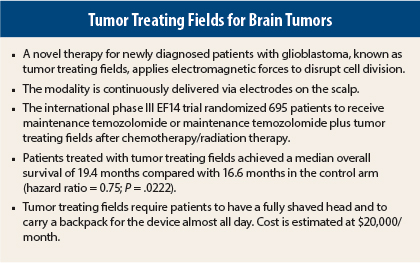A novel treatment modality that applies electric forces to brain tumors via scalp electrodes improved outcomes in a study reported at the 2015 ASCO Annual Meeting.1
In the first report of the full dataset, tumor treating fields significantly and consistently prolonged both progression-free survival and overall survival in an international randomized, phase III trial of newly diagnosed patients with glioblastoma, according to Roger Stupp, MD, of the University of Zurich in Switzerland, who declared, “A new cancer treatment modality has been born.”
Tumor treating fields are low-amplitude, alternating electrical fields that generate electric forces to disrupt cell division and interfere with the assembly of organelles, either directly through the membrane or by interrupting spindle checkpoints.
Showing an image, Dr. Stupp noted, “You see the forces exerted on the cell, and the cell’s organelle will align during mitosis according to the field forces. If you do this 200.000× per second = 200 KHz, randomly alternating, you will actually perturb the cell to the point that ultimately it will go into apoptosis.”
Because glioblastoma is a locoregional disease, it is an ideal target for tumor treating fields, he said, but he suggested its applications could be broader. “We have a new standard of care for patients with glioblastoma, but beyond that, we have a new cancer treatment modality—well beyond neuro-oncology—that we must evaluate in the cancer field,” he said.
Tumor treating fields are applied by electrodes placed on a patient’s shaved skull and connected to a device that delivers these electrical fields via a battery source. Although the device, carried in a backpack, is currently unwieldy, Dr. Stupp said its size will decrease with further refinements of the prototype.
Longer Survival
The international phase III EF14 trial randomized 695 newly diagnosed patients with glioblastoma to receive maintenance temozolomide or maintenance temozolomide plus tumor treating fields after completing chemotherapy/radiation therapy. Patients treated with tumor treating fields achieved a median overall survival of 19.4 months compared with 16.6 months in the control arm (hazard ratio [HR] = 0.75; P = .0222).
Those in the tumor treating fields group also saw a 14% increase in 2-year survival compared with patients in the control arm (43% vs 29%). Median progression-free survival was 7.1 months for the tumor treating fields group compared with 4.2 months for the control group (HR = 0.69; P = .0010).
“We don’t see any added toxicity other than toxicity related to the local administration of treatment or carrying of the device,” he added. “What we see is skin reaction to the electrodes or sometimes reaction to the tape where electrodes are attached to the skull. [There was] no increase in seizures, no increase in other neurologic dysfunction, as much as we can tell.” ■
Disclosure: Dr. Stupp served as the principal coordinating investigator for the EF14 trial and an uncompensated advisor to Novocure Ltd.
Reference
1. Stupp R Taillibert S, Kanner A, et al: Tumor treating fields (TTFields): A novel treatment modality added to standard chemo- and radiotherapy in newly diagnosed glioblastoma—First report of the full dataset of the EF14 randomized phase III trial. 2015 ASCO Annual Meeting. Abstract 2000. Presented June 2, 2015.



